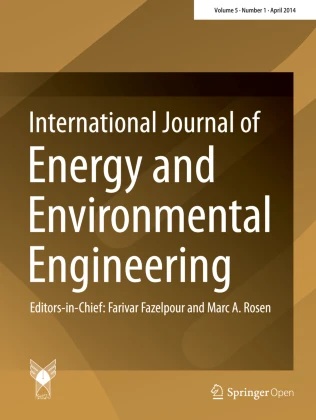High efficient solar cells through multi-layer thickness optimization using particle swarm optimization and simulated annealing
- Faculty of Engineering, Shahid Beheshti University, Tehran, IR

Published in Issue 2022-09-26
How to Cite
Kargaran, H., Bayat, E., Hassanzadeh, A., & Alahyarizadeh, G. (2022). High efficient solar cells through multi-layer thickness optimization using particle swarm optimization and simulated annealing. International Journal of Energy and Environmental Engineering, 14(4 (December 2023). https://doi.org/10.1007/s40095-022-00541-1
Abstract
Abstract In a comparative study, a solar cell structure’s layer thicknesses were optimized using particle swarm optimization (PSO) and simulated annealing (SA). The ideal short-circuit current density was considered as the cost function for both algorithms to minimize the number of function evaluations (NFEs) needed to obtain the optimal thicknesses of the structure layers (ZnO and MoOx layers), separately and simultaneously, being single- and multi-layer optimization. The results were compared to those of genetic algorithm (GA) and brute-force methods that have been reported in the literature. In the single-layer optimization, the results obtained by PSO indicated that the maximum required NFEs for optimizing ZnO was 33.1 ± 23.16 compared to 81 for the brute-force method and 78.16 ± 1.65 for the GA. The PSO method needed 19.6 ± 11.7 NFEs for optimizing the MoOx layer, while, as was reported in Ref. Vincent (E 13:1726 2020), GA optimized this layer by 13.05 ± 3.24 in the best manner by the Roulette wheel method. Both single-based and population-based approaches were implemented for the SA. The results obtained by SA indicated that the required NFEs were estimated higher than that of the GA due to the small search space. The required NFEs for two-layer optimization using PSO amount to 111.27 ± 60.1, which is considerably lower than the 1758.77 ± 39.75 of GA. The NFEs are significantly lower than the similar value obtained using the brute-force approach and GA, even with the highest SD value. In the case of two-layer optimization, SA estimated 65.63 ± 21.1 and 575.76 ± 301.64 NFEs using single-based and population-based methods, respectively.Keywords
- Particle swarm optimization (PSO),
- Simulated annealing (SA),
- Solar cell,
- Optimization,
- Efficient thickness
References
- Li et al. (2022) Solar energy utilisation: current status and roll-out potential https://doi.org/10.1016/j.applthermaleng.2022.118285
- Korfiati et al. (2016) Estimation of the global solar energy potential and photovoltaic cost with the use of open data (pp. 17-29) https://doi.org/10.5278/ijsepm.2016.9.3
- Güney (2022) Solar energy and sustainable development: evidence from 35 countries (pp. 187-194) https://doi.org/10.1080/13504509.2021.1986749
- Kannan and Vakeesan (2016) Solar energy for future world: - a review (pp. 1092-1105) https://doi.org/10.1016/J.RSER.2016.05.022
- Milichko et al. (2016) Solar photovoltaics: current state and trends (pp. 727-772) https://doi.org/10.3367/UFNE.2016.02.037703/XML
- King et al. (2000) Next-generation, high-efficiency III-V multijunction solar cells https://doi.org/10.1109/PVSC.2000.916054
- Pakhanov et al. (2018) State-of-the-art architectures and technologies of high-efficiency solar cells based on III–V heterostructures for space and terrestrial applications (pp. 187-202) https://doi.org/10.3103/S8756699018020115
- Yamaguchi (2012) Japanese R and D activities of high efficiency III-V compound multi-junction and concentrator solar cells (pp. 265-274) https://doi.org/10.1016/J.EGYPRO.2012.02.031
- Miller, B., Ranum, D.: Problem-solving with algorithms and data structures release 3.0, Franklin, Beedle & Associates (2013)
- DIab et al. (2020) Coyote optimization algorithm for parameters estimation of various models of solar cells and PV modules (pp. 111102-111140) https://doi.org/10.1109/ACCESS.2020.3000770
- Farah et al. (2022) Parameter extraction of photovoltaic models using a comprehensive learning Rao-1 algorithm https://doi.org/10.1016/J.ENCONMAN.2021.115057
- Kharchouf et al. (2022) Parameter’s extraction of solar photovoltaic models using an improved differential evolution algorithm https://doi.org/10.1016/J.ENCONMAN.2021.114972
- Hemeida et al. (2022) Multi-objective multi-verse optimization of renewable energy sources-based micro-grid system: real case https://doi.org/10.1016/J.ASEJ.2021.06.028
- Alavi et al. (2017) Using information technology to add value to management education (pp. 1310-1333) https://doi.org/10.5465/257035
- Ardito et al. (2005) An approach to usability evaluation of e-learning applications (pp. 270-283) https://doi.org/10.1007/S10209-005-0008-6
- Boehner et al. (2007) How emotion is made and measured (pp. 275-291) https://doi.org/10.1016/J.IJHCS.2006.11.016
- Meer (2007) Simulated annealing versus metropolis for a TSP instance (pp. 216-219) https://doi.org/10.1016/J.IPL.2007.06.016
- Niknam (2006) An approach based on particle swarm optimization for optimal operation of distribution network considering distributed generators https://doi.org/10.1109/IECON.2006.347222
- Niknam et al. (2008) An efficient hybrid evolutionary algorithm for cluster analysis (pp. 300-307)
- Rajan and Mohan (2007) An evolutionary programming based simulated annealing method for solving the unit commitment problem (pp. 540-550) https://doi.org/10.1016/J.IJEPES.2006.12.001
- Saber et al. (2007) Fuzzy unit commitment solution—A novel twofold simulated annealing approach (pp. 1699-1712) https://doi.org/10.1016/J.EPSR.2006.12.002
- Vincent et al. (2020) Application of genetic algorithm for more efficient multi-layer thickness optimization in solar cells https://doi.org/10.3390/EN13071726
- Anabestani, H.: Investigation on performance enhancement of micro-sized IR photodetectors, UWSpace.
- http://hdl.handle.net/10012/17406
- (2021)
- Kennedy and Eberhart (1942) Particle swarm optimization (pp. 1942-1948) https://doi.org/10.1109/ICNN.1995.488968
- Kennedy, J.F., Eberhart, R.C., Shi, Y.: Swarm intelligence, vol. 512. Morgan Kaufmann Publishers, San Francisco (2001)
- Niknam et al. (2009) An efficient hybrid evolutionary optimization algorithm based on PSO and SA for clustering (pp. 512-519) https://doi.org/10.1631/JZUS.A0820196
- Kirkpatrick et al. (1983) Optimization by simulated annealing 80(220) (pp. 671-680) https://doi.org/10.1126/SCIENCE.220.4598.671
- Rutenbar (1989) Simulated annealing algorithms: an overview (pp. 19-26) https://doi.org/10.1109/101.17235
- Siddique and Adeli (2016) Simulated annealing its variants and engineering applications https://doi.org/10.1142/S0218213016300015

 10.1007/s40095-022-00541-1
10.1007/s40095-022-00541-1











